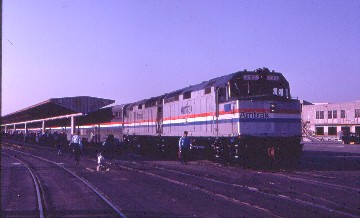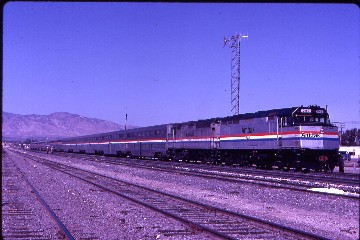
It was a bright Sunday morning as Cindy Piehl and I drove to Los Angeles Union Station for an excursion operated by the Pacific Railroad Society using the equipment that laid over in Los Angeles from the Sunset Limited pool. This works because of the Sunset Limited tri-weekly schedule. We parked and entered the grand building walking to the gate where we met the rest of our trip's passengers. They turned us loose and we went down the long tunnel and up the ramp to the track where we found our car in this fourteen car consist. We boarded an ex Santa Fe Hi-level coach and settled in for our trip today. We departed right on the advertised time and headed out to Mission Tower where we crossed the Los Angeles River taking the route that heads down the middle of the San Bernardino Freeway. We were going to be the first passenger train over the Southern Pacific's Palmdale Cutoff then out to Mojave where the train would be turned for our return. We would take the Sunset's route east to West Colton Yard and join the Palmdale Cutoff there. The cars on the freeway must have been shocked to see an eastbound passenger train at this time of morning. The looks the drivers and passengers give you when you are on a train in the middle of their freeway are priceless. We made great time through here and all to soon we were curving on the high viaduct off of the freeway to reach the mainline at El Monte. We crossed the San Gabriel River before passing the north side of SP's City of Industry Yard. We headed east down the Sunset Route through Walnut to Pomona where we made a brief passenger stop. Now in the San Bernardino Valley we cruised east passing through Montclair and Ontario, by the airport before passing through the Kaiser Yard that serves the large Kaiser Steel Plant north of the freeway. We ran along the San Bernardino Freeway to West Colton Yard where we were routed around the south side of the facility so everyone could have a good look as we took a mini tour. We stopped long enough to add a SD-40E to the point of our train as a helper for our long fourteen car train. We passed the fueling racks and the outbound yard before we headed to the maze of switches needed to go through to reach the Palmdale Cutoff.
There was an air of excitement as we passed through each of those switches to gain access to the Palmdale Cutoff and new mileage for everyone on this train except the SP Crew. The train slowly climbed the short but steep grade to get over the bypass track and Interstate 10 to reach Slover siding. People were out to record the historical significant of our passage over there tracks. We travelled due north the length of Slover before we crossed over the Santa Fe's 2nd District with the view east showing the west end of ATSF's "A" Yard. We passed Bench, the junction with the former Pacific Electric San Bernardino Line before making a slight "S" turn. We next crossed Lytle Creek Wash and climbed on a hill above the homes of Duffy Street. We turned to the northwest leaving San Bernardino behind heading towards Cajon Pass.
Some history of the Palmdale Cutoff will now be given. The Taylor Yard in Los Angeles in the 1950's was extremely congested causing great delays for through freight trains in and out of the Los Angeles Basin. In the mid 1950's SP discussed with Santa Fe building a line from Palmdale to Summit with them operating over the Santa Fe rails to Summit. If this agreement would have taken place, the Santa Fe would also be able to operate over this new track cutting the distance off of their northern California run. When no agreement could be reached, the SP gave up on that idea instead building a line from Palmdale to Colton of 78 miles at a cost of $22 million. The ruling grade would be 2.2 percent and maximum curvature would be six degrees. Construction started on April 5th, 1966 with the final spike being driven on June 29th, 1967. There are seven sidings on the line from east to west they are: Slover, Dike, Canyon, Hiland, Phelan, Wash and Palmdale 2. The line was built with no signaling and operated by train orders.
We were closing in on the gap between the San Gabriel Mountains on the west and the San Bernardino Mountains on the east to the passage created by the San Andres Fault called Cajon Pass as we bridged Institution Rd. We ran along the dump on the east side of the train on a fill as the tracks closed in on the Santa Fe tracks which the Union Pacific has joint use of from Riverside Jct to Dagget. We reached the east end of Dike siding located right on top of the dike of Cajon Creek. To the west on the hills was the Glen Helen Regional Park as we came to Devore and the west end of Dike before we crossed Devore Road prior to crossing Cajon Creek Wash and ducking under Interstate 15. The canyon narrows as we passed a location the SP crews called Skin Ranch, a nudist colony. The train was really working up the grade as over to the east on old Highway 66 {Cajon Blvd} the pacers are busy doing what they do best. We are higher above the Santa Fe double track mainline as we passed the location of Kennbrook on that railroad before we made a broad sweeping curve to Blu Cut and the train's crossing of the San Andres Fault. Just to the north of the tracks here after Swartout Canyon Rd is a sag pond called Lost Lake created by the action of the fault. The road turnout at Blu Cut were full of people trying to get that one special picture of our train. We are about forty feet above the ATSF Tracks as we made a left hand turn to the north high above the location of the former campground where I camped once as a Boy Scout. We are in the narrowest part of the canyon as we near Cajon siding on the ATSF but our tracks took us directly to Sullivan's Curve with it's unique rock structures. It was funny after all of the trips on the ATSF over Cajon Pass, I felt right at home on this new trackage. Many photographers were here to get our picture. The trip around the curve had a special excitement to it. Canyon siding started at the east end of the curve and we followed it's path to it's west end near where we crossed over Highway 138. We crossed Cajon Creek before passing below the Mormon Rocks to the Davis Ranch where we turned to the east. We ducked under Interstate 15 before bridging the former path of Route 66 and cutting through the slopes while the Santa Fe tracks below pass through the only two tunnels on Cajon Pass. We run across the slope climbing steadily with the two ATSF tracks coming closer together below us having split back at Cajon. We turned to the southeast passing underneath the high power lines through a deep cut to Hiland and the Summit of Cajon Pass on this line and the start of a 9097 foot siding where our helper locomotive was cut off as it would no longer be needed.
Continuing railroad west we were high above the Summit Valley which the ATSF follows down to Victorville and points east when we turned north onto the high desert with the ever present Joshua Trees. We passed the switch to the siding at Hivolt before turning to the northwest. We ran over cut and fills underneath Interstate 15 before we crossed the Oro Grande and Manzanita Washes. We crossed Phelan Road before reaching Phelan Siding. The train was really running well on the slight descending grade as we crossed Horse Canyon Wash and a few miles after Sheep Creel Wash before we bridged the California Aqueduct and exited San Bernardino County for Los Angeles County. We crossed over the Palmdale Rd {CA 18} turning to the west, followed by Montaine Creek and Mescal Washes. We reached Wash siding before we crossed Graham, Boulder, Grandview, Big Rock and Little Rock Washes. The train crossed over the Pearblossum Highway before reaching Palmdale 2 siding, the last of the sidings on the Palmdale Cutoff. We made a right hand turn crossing over the Sierra Highway and to Palmdale Junction where the Saugus Line the original line to Los Angeles was reached. We were now at the west end of the Palmdale Cutoff.
We turned north passing through Palmdale crossing Sierra Highway at grade before passing the huge Lockheed Plant as we reached Denis siding. The train sped north passing through Lancaster passing Oban siding, entering Kern County before zipping through Rosamond. Here the train climbed Ansel Hill reaching the top at Ansel siding. We descended the north side of Ansel Hill passed Purdy Metals to east Mojave where the Santa Fe line from Barstow joined the route for the trip over the Tehachaphi Mountains. We ducked under Highway 14 and were lined into the yard to be turned on the wye of the Oak Creek Branch. We made this move very slowly and once done we were allowed to detrain as the crew prepared for our trip back. I took another picture of our train.

Cindy and I really enjoyed ourselves on a most interesting first train trip over the Palmdale Cutoff to Mojave. We returned to Los Angeles with a less enthusiastic group of passengers as we all enjoyed a quiet trip back to Los Angeles Union Station back over the Palmdale Cutoff and back on the Sunset Route into the Sunset towards home.